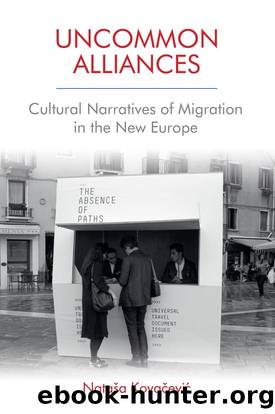Uncommon Alliances by Kovačević;

Author:Kovačević;
Language: eng
Format: epub
Publisher: Edinburgh University Press
Haunted European homes in Soul Tourists
Bernardine Evaristoâs Soul Tourists counteracts the whitewashing of European history as its protagonists, Stanley and Jesse, attempt to come to terms with their postcolonial backgrounds and sense of (un)belonging in Great Britain. While the novel addresses the intricacies of British postcolonial heritage and race relations, it places these issues in the larger context of European history, which, Evaristo suggests, is haunted by non-white ghosts that pop up in official accounts, rumours, literary texts and lineages from England to Russia. In a magical realist fashion, these ghosts confront Stanley and Jesse during their travels around Europe, on which they embark as a way of escaping the ennui of Stanleyâs nine-to-five job and after initiating a passionate love affair. Evaristoâs preoccupation with exploding the founding myth of white Europe is foreshadowed in an earlier novel, The Emperorâs Babe (2001), where Roman Britain is âglobalisedâ through the presence of Africans and Asians in Londinium. While Soul Tourists imagines all of Europe as a multicultural melting pot to help the protagonists negotiate a sense of belonging on this continent, The Emperorâs Babe casts London as a place settled by non-white subjects from the vast Roman empire, which is as multicultural as Rome.
Evaristo wrote The Emperorâs Babe while she was a poet in residence at the Museum of London,15 which nonetheless didnât provide her with much scholarship on multicultural Londinium. The construction of this history, therefore, has been partly speculative and partly inspired by available historical knowledge, which suggests that âthere were black soldiers in the Roman army at Hadrianâs wall in the early third centuryâ and that thanks to good roads, Romans frequently travelled across vast distances of the empire, including from Africa to Europe (qtd in Hooper 2006: 6). The historical basis of this book was made possible by Peter Fryerâs account of early African presence in Britain in Staying Power (1984), as well as by a subsequent surge in publications, journals and conferences dedicated to understanding the overlooked contributions of Africans to European history.16 However, despite this renewed interest in exploring the non-white presence in Great Britain preceding post-World War II waves of immigration, we do not yet, and may never have, reliable information about multicultural Londinium. While Evaristoâs historical speculations in The Emperorâs Babe and Soul Tourists are probable, they address this impossibility of ever knowing the firm line between fact and fiction, which is reflected in her playful mixing of magical and realist elements, humour and seriousness. More important than corroborating historical events is allowing for the possibility of imagining a different history than the one that has become dominant, even if its unpacking is permanently frustrated by the limitations of available archival data. The impact of Evaristoâs strategy has been quite powerful in that the Museum of London integrated her work into their displays (Muñoz-Valdivieso 2009: 169), including quotes from The Emperorâs Babe and a âblack Roman character played by an actor who guides people around the Roman part of the Museumâ (Hooper 2006: 6).
Download
This site does not store any files on its server. We only index and link to content provided by other sites. Please contact the content providers to delete copyright contents if any and email us, we'll remove relevant links or contents immediately.
4 3 2 1: A Novel by Paul Auster(11788)
The handmaid's tale by Margaret Atwood(7447)
Giovanni's Room by James Baldwin(6808)
Asking the Right Questions: A Guide to Critical Thinking by M. Neil Browne & Stuart M. Keeley(5355)
Big Magic: Creative Living Beyond Fear by Elizabeth Gilbert(5351)
Ego Is the Enemy by Ryan Holiday(4956)
On Writing A Memoir of the Craft by Stephen King(4662)
The Body: A Guide for Occupants by Bill Bryson(4582)
Ken Follett - World without end by Ken Follett(4443)
Bluets by Maggie Nelson(4261)
Adulting by Kelly Williams Brown(4232)
Eat That Frog! by Brian Tracy(4149)
Guilty Pleasures by Laurell K Hamilton(4116)
White Noise - A Novel by Don DeLillo(3829)
The Poetry of Pablo Neruda by Pablo Neruda(3814)
Fingerprints of the Gods by Graham Hancock(3738)
Alive: The Story of the Andes Survivors by Piers Paul Read(3730)
The Book of Joy by Dalai Lama(3697)
The Bookshop by Penelope Fitzgerald(3619)
